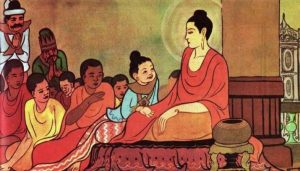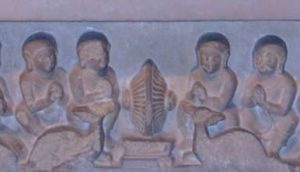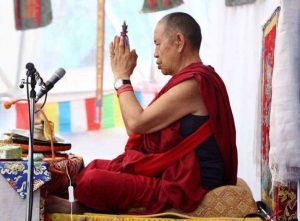Beginner’s Mind is a special project from BDG collecting insightful essays written by US college students who have attended experiential-learning courses related to Buddhism. Some of the authors identify as Buddhists, for others it is their first encounter with the Buddhadharma. All are sharing reflections and impressions on what they’ve learned, how it has impacted their lives, and how they might continue to engage with the teaching.
Gus Demerath wrote this essay for his course Brutal Buddhism (fall 2022) at Williams College in Massachusetts. He is part of the graduating class of 2025, majoring in Sociology and concentrating in Latinx Studies. Born and raised in Shreveport, Louisiana, Gus likes to do as much as possible outdoors, including practicing the cello, which he plays with much joy.

I entered this course during the Fall semester of my sophomore year at Williams College hoping to learn more about Buddhism. Of course, I was expecting to be surprised. The title of the class, “Brutal Buddhism,” forced us to file away our preconceptions to try to understand the honest, sometimes violent realities involving Buddhism. Last year I took a class with Prof. Jason Storm called “Virtue Ethics.” The main idea for this course was that virtue ethics—guiding principles and a road map to living a flourishing life—could be applied to daily life and academia through repetition and practice. We studied Buddhism, Daoism, and Confucianism, and I left this class feeling prepared to continue my spiritual and normal journey through life, possibly by deepening my connection to my vague, spiritual self, my Quaker history, or even my mom’s Catholic history. Seeing “violence” in the title for this class under the “Anthropology” and “Religion” tabs on my class schedule website, I understood that it may not provide the same sense of spiritual growth or virtuous stability. Recognizing this, I did not expect to find any sort of abstract, spiritual, or non-spiritual self-growth of any sort. What I did find was refreshing academic growth with wonderful class conversations and a novel way of looking at our diverse world, its many cultures, religions, and problems.
Before the class, I had thought of Buddhism as a solution for inner discontent. I thought that taking a class in the religion department would help me mature and provide some sort of stability. Another side of me was interested in the anthropological and social factors involved. I was curious about all of it, academic and emotional. I knew that I would grow, but didn’t know how. In telling my friends that I was taking the class, which I called “Buddhism and violence,” I already suspected my preconceived notions of Buddhism as a nonviolent religion were incorrect, understanding that any human can make mistakes or become angry, Buddhist monks included. As I dove into the class, I was happy to not only gain a comprehensive review of Buddhism in Southeast Asia, but also examples of violence in the present day. I found that situating our case studies of violence in Myanmar, Sri Lanka, and Thailand in the greater socio-political context of the present was just as important as understanding the Buddhist scriptural links and excuses for the violence. Coming out of each case study, I started to understand that, just as with any historical event, acts of violence were often just a small piece in the larger social machinery. Violent rhetoric and brutal actions were tangled within greater ideologies, movements, and political parties. Cash, revenge, favors, historic-tensions, love, hate, and confusion are all part of the swirling storms that pit people against each other. It is not—and never will be—black and white.
This is my biggest takeaway from the class (heavily informed by Prof. Kerekes’ final words to us on the last day of class): When discussing a religion, nation, language, and culture that is foreign to most of our society and community, we must be conscious of our biases and the way we interact with information from afar. Our perspective, a Western one, orientalizes and marks us with subjectivity. Our place, thousands of miles away and without being there, desensitizes us. When forming conclusions, we must be holistic in our analytical process. We must look at all sides of a conflict, even when it seems to solely implicate a religious sect or ethnic enclave. We must dig a little deeper, question our assumptions and conclusions, and question some more. This is especially true in our current era of global politics and far-reaching capitalist markets. More people are affected by commercial choices than ever before. More people can vote than ever before. Translations are more available than ever before. Even if globalization is homogenizing us, we must not forget the myriad differences that linger over the globe: inequality, class, sex, race are all factors that must be considered.
Where to go from here? I’m not entirely sure. We didn’t reach any perfect answers in the class, and I don’t believe we were meant to. I dove in and tried to understand as much as I could, but still came up short. How do we take in conflicting points of view? Does it start with being empathetic? Maybe. The global reach at our fingertips by tapping on Google lets us see whatever we want, but I don’t think that necessarily helps us understand each other better. Being in a place, talking to people, listening to them, is when I believe we connect.
When I go to Ecuador (where my family is from), I see people who look like me. Sometimes I feel like we come from two different universes, and in some ways we do. I don’t fully understand their rapid Spanish so I feel like I can’t know them. Yet we talk and see our differences and our similarities. We aren’t so far apart. We still share the same sky, worship the same fútbol team. We aren’t too different, just grounded in our respective places, holding deep understandings of our local knowledge and communities. We are both meaning-making and care-giving.
We share this with everyone in the world. Maybe this is how to look at it: to see the meanings embedded in places, beliefs, and connections; to see what we share and what we don’t; to recognize the many lenses and perspectives that take us off course. Then we sit down, share food, and come together again.
Related features from BDG
Embracing the Unknown – A New Perspective on Buddhism
Shifting Perspectives: My Relationship with Religion and with Buddhism
Activism and Action on the Path of Engaged Buddhism











